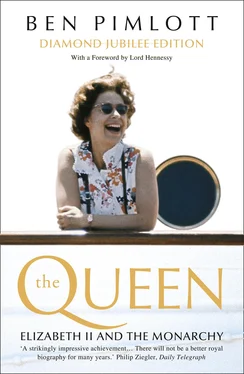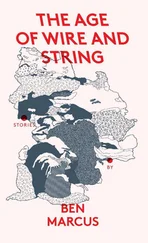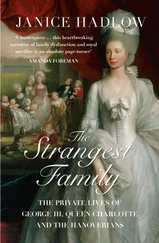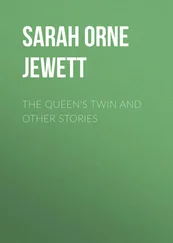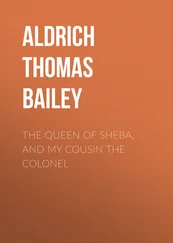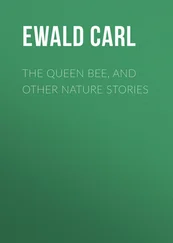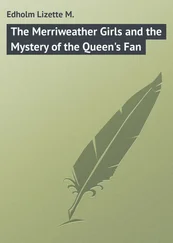Since 1918 – if not before – the British Royal Family had been the premier dynasty; and now, with fewer surviving monarchies than ever, its pre-eminence was even more apparent. ‘You are the big potato,’ Smuts was overheard saying to the King’s mother at the wedding-eve party; ‘all the other queens are small potatoes.’ 52Nobody doubted it or that this was an occasion for big potatoes to show cousinly solicitude to small ones, whatever their circumstances. Lady Airlie cast her mind back to 1939 or even 1914. Old friends were reunited, she wrote, old jealousies swept away. 53‘It was a tremendous meeting place,’ recalls Princess Margaret. ‘People who had been starving in little garrets all over Europe, suddenly reappeared.’ 54Queen Alexandra of Yugoslavia likened the atmosphere to that of a boarding school, in which all the royal families belonged to the same house: the Wedding reminded her of a reunion of school friends, all ‘shedding their grown-up facade, and romping together in an abandon of gossip, leg-pulling and long-remembered family jokes’. Many of the visiting royals – especially the mendicant ones, who had their travel expenses discreetly paid by the Windsors – crowded round a communal table in the dining room at Claridges, where they were put up, adding to the illusion of an unruly and cacophonous academy. 55
However, simple accounts of happy high jinks, and of bygones being bygones, did not give the whole picture. Delicate decisions had to be made. Though Philip’s mother was invited, his three surviving, German-married sisters were not. Nor was the Duke of Windsor, who spent the day morosely in New York in his Waldorf Towers suite. A few who came might have done better to have stayed away. ‘When I am back behind the Iron Curtain,’ Queen Helen of Romania remarked during her brief stay, ‘I shall wonder whether this is all a dream.’ 56Her words acquired a special poignancy because the Government in Bucharest used the opportunity afforded by King Michael’s absence to declare a republic.
On the eve of the main event there was a dinner for foreign royalty, and a grand party at the Palace, attended by crowned heads, presidents and premiers. Much was made of the down-at-heel condition of royal adornments, of tiaras taken out of storage and dusted down: as though the ostentation was easier to justify if it was seen as a fancy dress parade, rather than the display of real luxury. Crown jewels were worn as if they were paste, almost apologetically – leading some of the kings and queens who still had thrones to feel superior. ‘Queen Juliana of the Netherlands was frightfully scathing about everybody’s jewellery,’ recalls Pamela Hicks, a bridesmaid. ‘“It’s so dirty,” she kept saying.’ 57Lady Airlie wrote that ‘anyone fortunate enough to have a new dress drew all eyes’. However, all the famous diamonds were visible, ‘even though most of them had not been cleaned since 1939’. 58
ONE TICKLISH question, which exercised the finest and most antiquarian minds at Buckingham Palace almost until the Wedding itself, was what Philip Mountbatten should be called and how he should be styled. Since he was no longer Greek, his royal title was meaningless, and anyway he had abandoned it; yet it was taken for granted that the Heiress’s consort could not remain a commoner. The problem was finding a suitable English title, and an appropriate rank. In choosing one, future children – including the future Heir or Heiress – had to be taken into account. Would they be named after their father or their mother? Consulted on this point, the Lord Chancellor, Lord Jowett, replied that the 1917 Proclamation which changed the Royal Family’s name to Windsor, did not include under the general rubric George V’s married female descendants. Elizabeth, and her issue, were excluded, and would take their names from her husband. 59
At the end of July, Dermot Morrah – who had covered the tour of South Africa for The Times and felt a passionate concern about the minutiae of royal etiquette – sent a memorandum to his editor, who passed it on to the Palace, listing some twenty alternative labels for Lieutenant Mountbatten, with comments on each. He gave ‘Edinburgh’ a high ranking. Though it had the drawback of lacking antiquity, ‘having been first conferred only in 1726,’ the adoption of it, he suggested, would be seen as a compliment to Scotland. Lascelles added his own notes, and passed on the list to the King. 60In view of Philip’s naval background, either the Earl or Duke of Greenwich was considered a possibility. 61Finally, Baron Greenwich, Earl of Merioneth, Duke of Edinburgh was agreed. However, the question of a ‘Royal’ Dukedom – whether Philip should be called ‘His Royal Highness’, following his marriage – still had to be sorted out. The King became greatly exercised on this issue. ‘Can you find out how Prince Henry of Battenberg who was Serene Highness was created Royal Highness by Q. Victoria on his marriage to Princess Beatrice?’, the King pencilled to Lascelles in August. ‘This will give me a Precedent in this case.’ In September, after consultations with the Home Secretary, it was decided to bestow the ‘HRH’ title which Philip had turned down before the engagement, but which his marriage to the Princess would justify. The King’s attention now turned to the complex question of his future son-in-law’s coat-of-arms. Rough sketches were commissioned, and the Monarch spent many productive hours poring over them, noting down his comments. 62
At the end of September, Philip’s transmogrification into an Englishman was completed with his formal reception into the Anglican Church by the Archbishop of Canterbury in the chapel at Lambeth Palace – at roughly the same time as his mother, Princess Alice, was making arrangements for the founding of her own Greek Orthodox order of working nuns. There was one more detail: in November, the King bestowed the Garter on both the Princess and Philip – though too late for the wedding service sheets, which described him as ‘Philip Mountbatten, RN’. Popularly, however, he had always been known as ‘Prince Philip’ – a title to which his wife, as Queen, finally gave regal sanction ten years later.
Courtiers continued to weigh him up. In late October, Philip accompanied Elizabeth on her last pre-marriage engagement, to launch the Cunard liner the Caronia from the Clydebank shipyard of John Brown and Co. On the way back, the royal train was delayed in a siding, and Jock Colville walked down the line with his employer’s fiancé, climbing with him into the signal box. ‘I watched P. narrowly,’ he recorded. ‘He is a strong believer in the hail-fellow-well-met as opposed to the semi-divine interpretation of Monarchy.’ However, during a conversation with some of the railwaymen, there was one ‘appalling gaffe’. When the signalman said jokingly that he was waiting for promotion until somebody died, noted Colville, ‘Philip replied, “Like me!” No doubt he meant in the Navy, but another interpretation was obvious.’ Colville wrote that he expected the future consort to be popular with the crowd, but that he could also be vulgar, and that his manner towards Princess Elizabeth at times was quite off-hand. 63However, even the Princess’s acidic private secretary was not immune from the rising tide of sentiment towards the young couple, and the sense of a storybook romance. Close contact with both of them also caused him to revise his opinions. ‘As the day drew nearer’, Colville acknowledged immediately after the Wedding, ‘I began to think, as I now sincerely do, that the Princess and Philip really are in love.’
He also wrote that Elizabeth ‘bore the pre-wedding strain with great good nature and cheerfulness’. 64Sometimes, it must have been hard. To the worries of any young bride were added an uncertainty about what to expect as the first married Heiress to the Throne of modern times, and the almost suffocating attentions of the world. Crawfie, seeing her former pupil’s nervousness, tried to help – by offering some advice. This took the form of a homily on the condition of matrimony, which reveals much about British attitudes (or at any rate Scottish lower-middle-class ones) in the 1940s. It was unwise, the governess explained, even in a royal union, to be too jealous or possessive a wife. ‘When you marry, you must not expect the honeymoon to last for ever,’ she told the young woman she had helped to bring up. ‘Sooner or later you will meet the stresses and strains of everyday life. You must not expect your husband to be constantly at your side or always to receive from him the extravagant affection of the first few months. A man has his own men friends, hobbies and interests in which you cannot and will not want to share.’
Читать дальше
